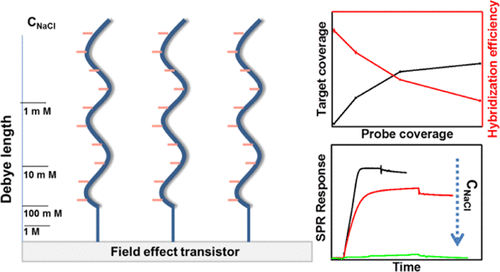Our official English website, www.x-mol.net, welcomes your
feedback! (Note: you will need to create a separate account there.)
Estimating Detection Limits of Potentiometric DNA Sensors Using Surface Plasmon Resonance Analyses.
ACS Sensors ( IF 8.2 ) Pub Date : 2019-12-23 , DOI: 10.1021/acssensors.9b02086 Xingxing Xu 1 , Asta Makaraviciute 1 , Eldar Abdurakhmanov 2, 3 , Fredrik Wermeling 4 , Shiyu Li 1 , U Helena Danielson 2, 3 , Leif Nyholm 5 , Zhen Zhang 1
ACS Sensors ( IF 8.2 ) Pub Date : 2019-12-23 , DOI: 10.1021/acssensors.9b02086 Xingxing Xu 1 , Asta Makaraviciute 1 , Eldar Abdurakhmanov 2, 3 , Fredrik Wermeling 4 , Shiyu Li 1 , U Helena Danielson 2, 3 , Leif Nyholm 5 , Zhen Zhang 1
Affiliation

|
As the signals of potentiometric-based DNA ion-selective field effect transistor (ISFET) sensors differ largely from report to report, a systematic revisit to this method is needed. Herein, the hybridization of the target and the probe DNA on the sensor surface and its dependence on the surface probe DNA coverage and the ionic strength were systematically investigated by surface plasmon resonance (SPR). The maximum potentiometric DNA hybridization signal that could be registered by an ISFET sensor was estimated based on the SPR measurements, without considering buffering effects from any side interaction on the sensing electrode. We found that under physiological solutions (200 to 300 mM ionic strength), the ISFET sensor could not register the DNA hybridization events on the sensor surface due to Debye screening. Lowering the salt concentration to enlarge the Debye length would at the same time reduce the surface hybridization efficiency, thus suppressing the signal. This adverse effect of low salt concentration on the hybridization efficiency was also found to be more significant on the surface with higher probe coverage due to steric hindrance. With the method of diluting buffer, the maximum potentiometric signal generated by the DNA hybridization was estimated to be only around 120 mV with the lowest detection limit of 30 nM, occurring on a surface with optimized probe coverage and in the tris buffer with 10 mM NaCl. An alternative method would be to achieve high-efficiency hybridization in the buffer with high salt concentration (1 M NaCl) and then to perform potentiometric measurements in the buffer with low salt concentration (1 mM NaCl). Based on the characterization of the stability of the hybridized DNA duplexes on the sensor surface in low salt concentration buffer solutions, the estimated maximum potentiometric signal could be significantly higher using the alternative method. The lowest detection limit for this alternative method was estimated to be around 0.6 nM. This work can serve as an important quantitative reference for potentiometric DNA sensors.
中文翻译:

使用表面等离振子共振分析估算电位DNA传感器的检测限。
由于基于电位分析的DNA离子选择性场效应晶体管(ISFET)传感器的信号因报告而异,因此需要对该方法进行系统的重新研究。在此,通过表面等离振子共振(SPR)系统地研究了靶标和探针DNA在传感器表面上的杂交及其对表面探针DNA覆盖率和离子强度的依赖性。可根据SPR测量值估算ISFET传感器可以记录的最大电位DNA杂交信号,而无需考虑感应电极上任何侧面相互作用的缓冲作用。我们发现,在生理溶液(离子强度为200至300 mM)下,由于进行了德拜筛选,ISFET传感器无法在传感器表面记录DNA杂交事件。降低盐浓度以扩大Debye长度会同时降低表面杂交效率,从而抑制信号。还发现由于空间位阻,低盐浓度对杂交效率的不利影响在具有较高探针覆盖率的表面上更为明显。通过稀释缓冲液的方法,估计DNA杂交产生的最大电位信号仅在120 mV左右,最低检测限为30 nM,发生在具有最佳探针覆盖率的表面上以及在含有10 mM NaCl的tris缓冲液中。另一种方法是在高盐浓度(1 M NaCl)的缓冲液中实现高效杂交,然后在低盐浓度(1 mM NaCl)的缓冲液中进行电位测量。基于在低盐浓度缓冲溶液中传感器表面上杂交DNA双链体的稳定性特征,使用替代方法估计的最大电位信号可能会明显更高。此替代方法的最低检测限估计约为0.6 nM。这项工作可以作为电位DNA传感器的重要定量参考。
更新日期:2019-12-25
中文翻译:

使用表面等离振子共振分析估算电位DNA传感器的检测限。
由于基于电位分析的DNA离子选择性场效应晶体管(ISFET)传感器的信号因报告而异,因此需要对该方法进行系统的重新研究。在此,通过表面等离振子共振(SPR)系统地研究了靶标和探针DNA在传感器表面上的杂交及其对表面探针DNA覆盖率和离子强度的依赖性。可根据SPR测量值估算ISFET传感器可以记录的最大电位DNA杂交信号,而无需考虑感应电极上任何侧面相互作用的缓冲作用。我们发现,在生理溶液(离子强度为200至300 mM)下,由于进行了德拜筛选,ISFET传感器无法在传感器表面记录DNA杂交事件。降低盐浓度以扩大Debye长度会同时降低表面杂交效率,从而抑制信号。还发现由于空间位阻,低盐浓度对杂交效率的不利影响在具有较高探针覆盖率的表面上更为明显。通过稀释缓冲液的方法,估计DNA杂交产生的最大电位信号仅在120 mV左右,最低检测限为30 nM,发生在具有最佳探针覆盖率的表面上以及在含有10 mM NaCl的tris缓冲液中。另一种方法是在高盐浓度(1 M NaCl)的缓冲液中实现高效杂交,然后在低盐浓度(1 mM NaCl)的缓冲液中进行电位测量。基于在低盐浓度缓冲溶液中传感器表面上杂交DNA双链体的稳定性特征,使用替代方法估计的最大电位信号可能会明显更高。此替代方法的最低检测限估计约为0.6 nM。这项工作可以作为电位DNA传感器的重要定量参考。











































 京公网安备 11010802027423号
京公网安备 11010802027423号